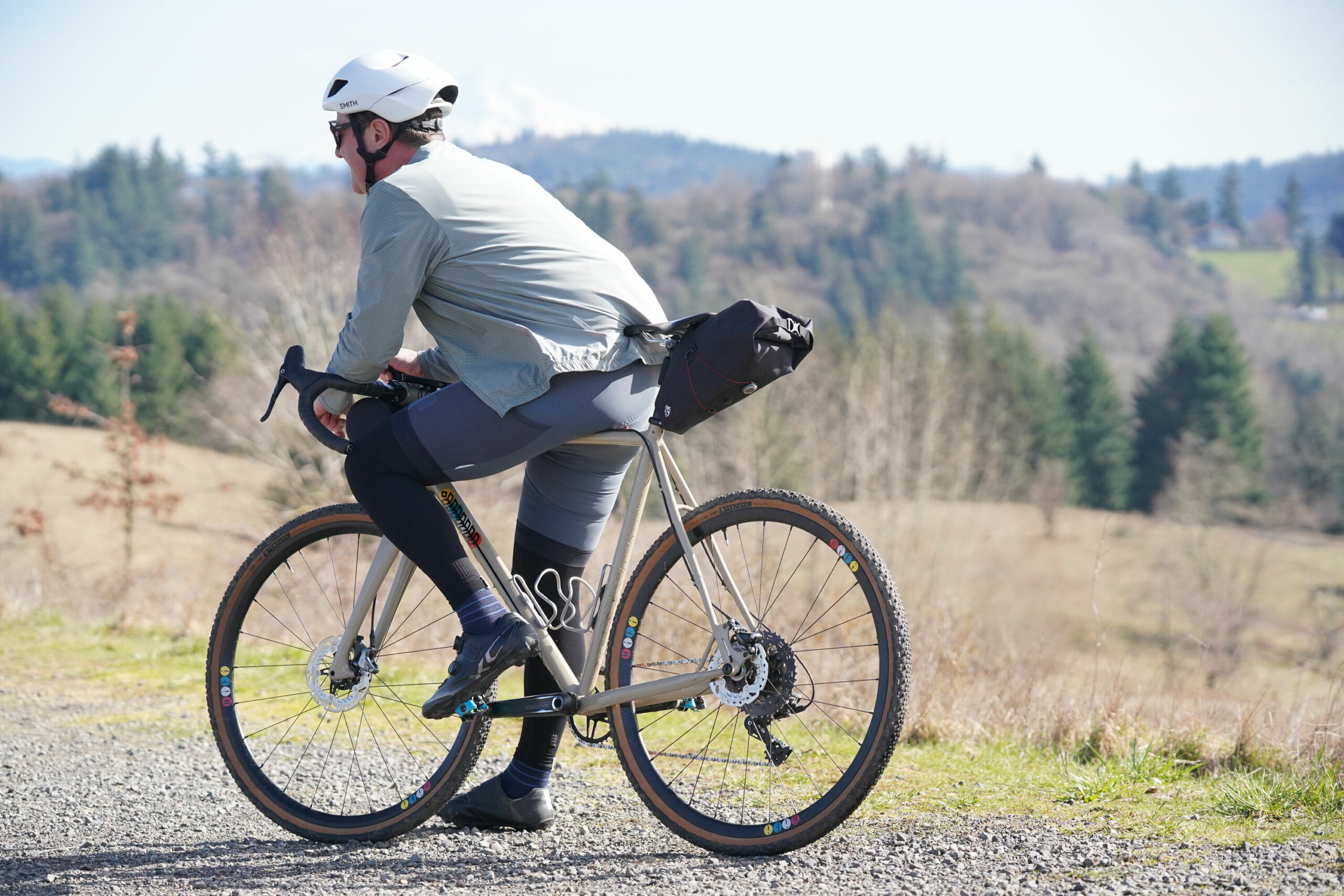By Lou Melini — The following products have been used by me since early this year and on my recent Mickelson Trail bikepacking tour. I was able to obtain discounted prices for the products through my volunteer work at the Bicycle Collective or through my son at Storm Cycles. The discounts were nice and there was no expectation of bias in reviewing the products.
[Editor’s note: See part 2 of this article.]
Trek Checkpoint SL5 Gravel-Specific Bicycle
My primary purpose in purchasing the Checkpoint was to replace my cyclocross bike. Last season I went over the bars once and on a separate course on a steep descent with a left hand turn I went into the barriers a couple of times. I’m in my 70’s so stability and better brakes are a priority. I am over 10 years from finishing on the podium. Now I simply care about finishing.
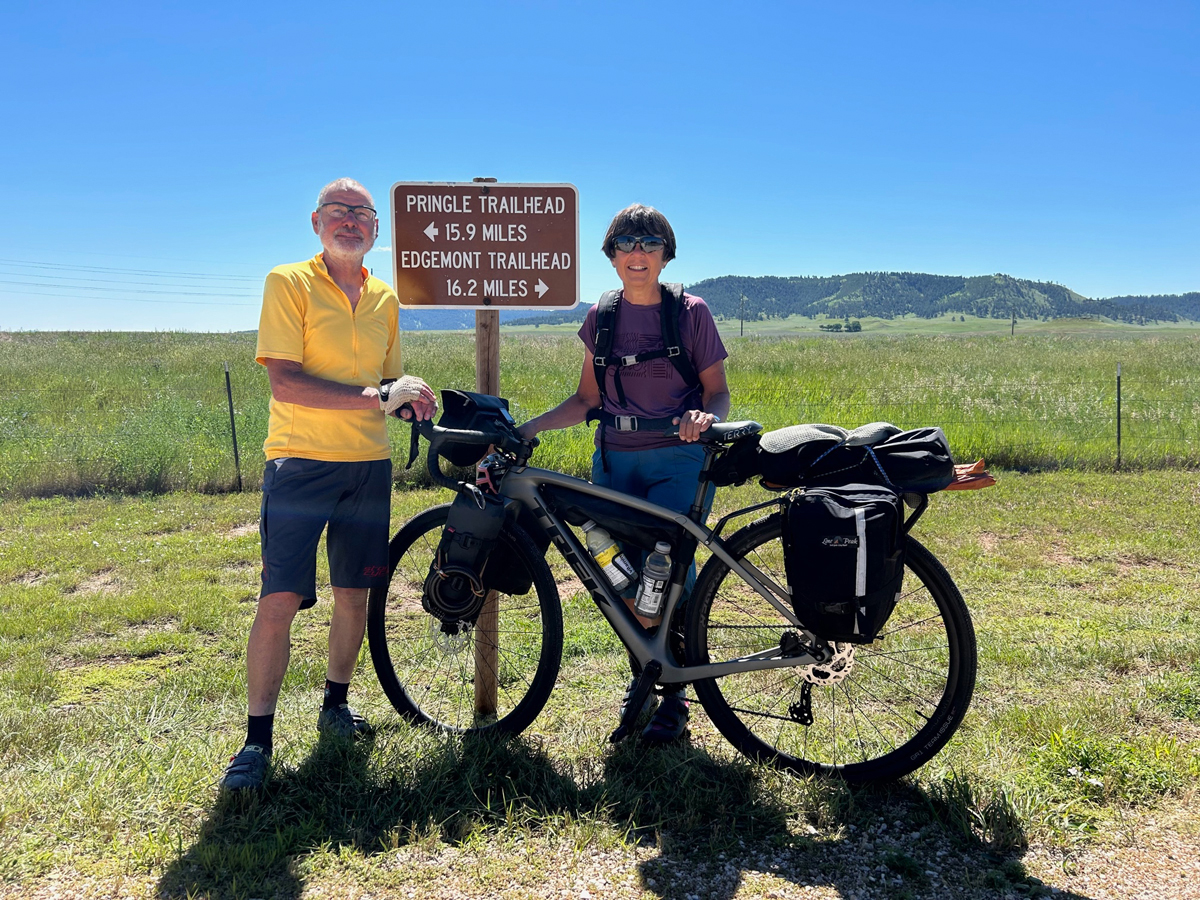
My oldest son Ben works at Storm Cycles in Park City. I asked him about a Trek Boone cross bike. He countered with the Checkpoint because he knows my needs beyond cross racing and felt that I would be happier with the gravel bike seeing the big picture of my needs. He was correct.
I now have over 1100 miles on the Checkpoint since the first of the year. I’ve taken it on the Little Wild Horse trail, The Jeremy Ranch loop that has a rutted gravel road out of Jeremy Ranch to Henefer. Then there is a gravel road through Henefer followed by the rail trail from Echo to Park City. I’ve ridden on the road with the Bonneville Cycling Club and now bikepacking on the Mickelson trail. In all these circumstances, the Checkpoint has been an excellent choice. It rides well as a road bike, perhaps due to the 24-spoked wheels. It has been stable on unpaved surface with 40 mm tires set up as tubeless. What was a selling point for me was that the bike had fittings in the carbon fiber frame for racks and fenders. I knew right away that this bike will be used for bikepacking. I simply love riding this bike.
I read a review of the aluminum Checkpoint in Adventure Cycling magazine by Dan Meyer. I’ve met Dan and have read a lot of his reviews in the magazine. He does a great job with his reviews. Dan enjoyed the bike much like I have. His primary concern was that gearing was not low enough for bikepacking. I would tend to agree with him. At this time, I have been in my lowest gear once, on the little wild horse ride, going up a relatively long steepish climb (absent bike packing weight). I am happy with the current gearing. I have some upcoming bikepacking trips so I will see if the gearing is good for me. I am also “only” 60 kg (132 lbs.) so I have always climbed well which could be seen as a biased account of the gearing. The bike Dan reviewed has a single chainring. My Checkpoint has a double chainring and has slightly lower gears than the Aluminum “Driftless” Dan reviewed. I think for most people that are not bikepacking up long grades will find, the gearing to be adequate.
The Trek Checkpoint SL5 is more than an entry-level gravel bike at a reasonable price. It is my first non-American made, custom-built bike by Waterford or Seven since the 90’s. It is quickly becoming my favorite all-around bike. Julie has the same bike, a big confidence builder for her on gravel. For more details go to the Trek bicycles website.
Bikepacking bags
I have use racks and panniers since 1975 when I rode across the U.S. for the first time. Julie and I travel comfortably, which means I carry a bit on the heavy side though my bags are rarely full except after a grocery store visit. How one travels is a matter of style, each person sets their own style. I expect a small learning curve as I pack my new bags that are of different sizes and shapes from what I am used to.
I went with bike packing bags for the Mickelson trail primarily because I am not sure how much weight the fitting in carbon fiber can be tolerated. Julie and I were able to fit all we needed in our new set-up, albeit a bit tighter. We used a cylindrical 3-bolt Salsa EXP series Anything Cage HD kit (that includes a bag) instead of my usual front panniers. I don’t know if front rack movement would put too much stress on the fork fittings hence the change. The Salsa bags have a total (listed) volume of just under 7 liters compared to the 30 liters of the Ortlieb sport packer bags I currently use on my front racks. The size and shape of the bags seem to be made to fit a Jet Boil cooking system as an 8-ounce fuel canister fits precisely in the bag (I use a different cooking system that did not fit in the bag). Clothing seems to efficiently fit in the bags avoiding wasted space. A 6-pack of bagels fits well for those that are curious. I will see if the front fork bags work on future trips.
Trek makes under-the-top-tube bags that are sized specifically for different Checkpoint frame sizes. You can purchase option thumb screws for a nice clean look to the bag vs. straps that fit around the top tube of the bike. I have kept this bag on my bike as I really like the utility of it. For traveling I put a pump with a gauge, my rain jacket, a few tools, hat, and neck gaiter. Julie and I had to use small water bottles in order for the bottles to fit on the bike but that may be more of a function of our small sized bikes (49cm and 52).
The handle bar bag, also a Salsa EXP series kit, carried our sleeping bag that is a quilt to sleep two. The bag is a 1982 down bag by Marmot with a Gore-Tex shell. With good care it has worked well for perhaps 600 nights. The sleeping bag and Exped pillows fit well in the waterproof bag. The kit came with an accessory bag that I found to be cumbersome to strap on, so that was left behind.
The Salsa bag that attached to my seatpost and saddle held the tent. Julie and travel by bike with a 3-person tent, roomy and comfy. The Salsa seat bag worked well, but since I used a rack and small panniers, I could have strapped the tent to the rack. The seat bag works well when I take of the rack for small errands. I purchased a Topeak bag for Julie but due to the stiffness of the bag it would not work with a rack. Perhaps another factor of a small bike.
I am sure others have different opinions of bags used for bikepacking. Each person will have individual biases. Go ride and have fun.
Outdoor Research Helium Rain Jacket
The OR Helium jacket is light, packable, sheds water and is warm. In addition, it is a scant 6.3 ounces (on my scale) including the hood. That is all of the good news. The weather in South Dakota was wetter and cooler than expected for late June. Rain, primarily evenings, in the days before and during the Mickelson trail ride were frequent. At times the rain was moderate but not prolonged. The jacket kept me warm and dry and packed well in my bag under the top tube of my bike. The OR Helium is not a cycling specific jacket but you may find the weight and packability of interest for bikepacking. It is comfortable to wear. The jacket is snug compared to the roomy Marmot PreCip and North Face equivalent that I have been using on bike trips. I am about 5’5”, 132 lb. frame. I could wear two thin long sleeve synthetics under the size small Helium, so I don’t wish to classify the jacket as too small. I found it just right for my needs.
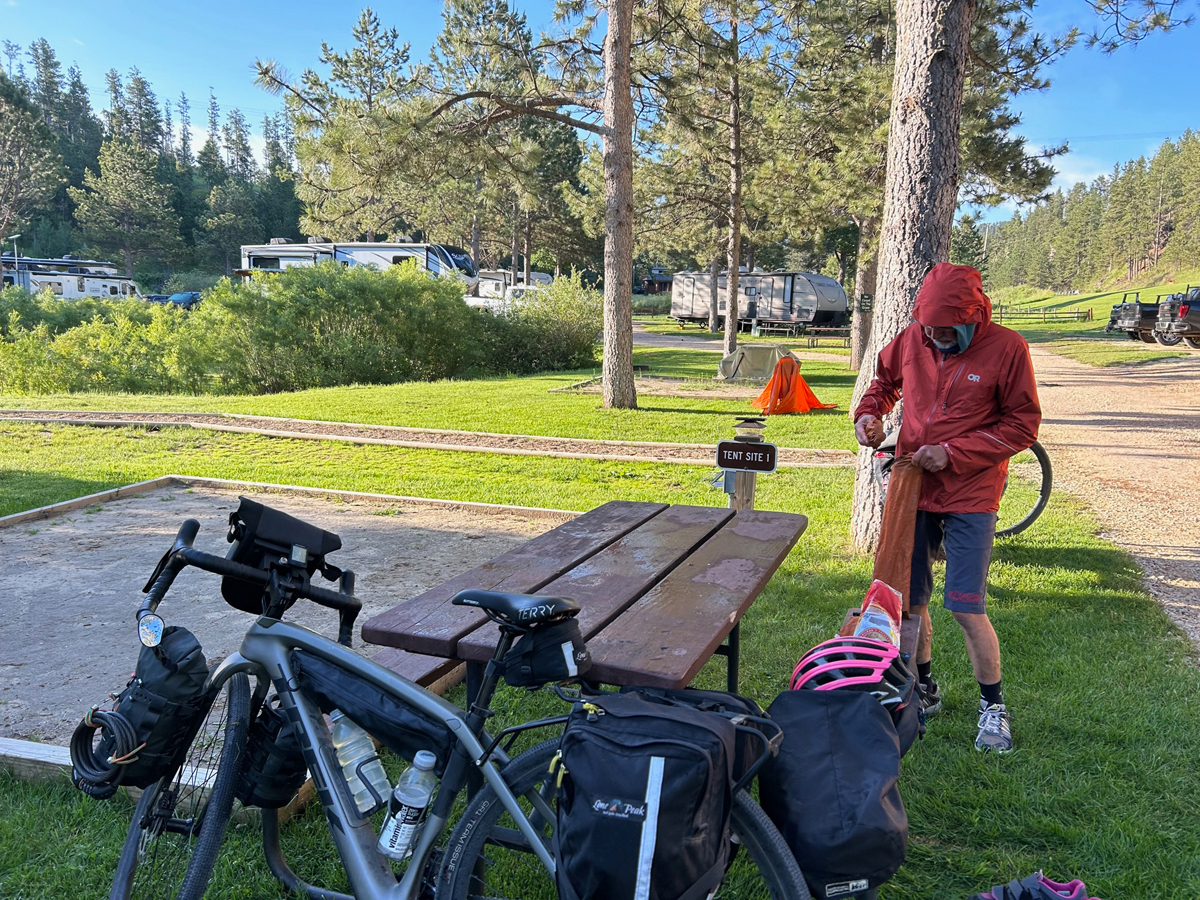
The reviews that I read state that the jacket will not tolerate a heavy rain nor a prolonged rain. Reviews also say that it is a “warm” jacket as it does not have pit zips. Because of my age and weight, I need the extra warmth which was provided by the jacket on cool mornings. I didn’t find it overly warm but my need for warmth is different than a younger person. I normally like pit zips but given weight and packability, I will be using the Helium on my bike travels over the next couple of years or longer as my Marmot PreCip is starting to show wear and my North Face is long past it’s waterproof capability.
The market for rain jackets is changing due to retailers (REI in particular) and many manufactures moving away from PFAS waterproofing. I am not going to get in to the environmental impact of long chain vs. short chain PFAS and other material being touted.
Race Face Chester flat pedals and Five 10 shoes
My son Ben equeathed his pedals and shoes to Julie for her early on-bike knee replacement rehab rides. She loved the pedals and shoe combo on her commuter bike. As I learned about shoe composition from my son, the sole of the Five 10 shoes is soft to “stick” to the metal projections on the pedal so that the two were made for each other. Julie and I debated about using flat pedals on the Mickelson Trail so I bought the same pedal/shoe combination that I put on my commuter bike for several weeks. I have found that compared to being clipped in (either via a strap or pedals) where I have 360-degree contact rotation, with the Chester pedals and shoes I have about 270 degrees of rotation.
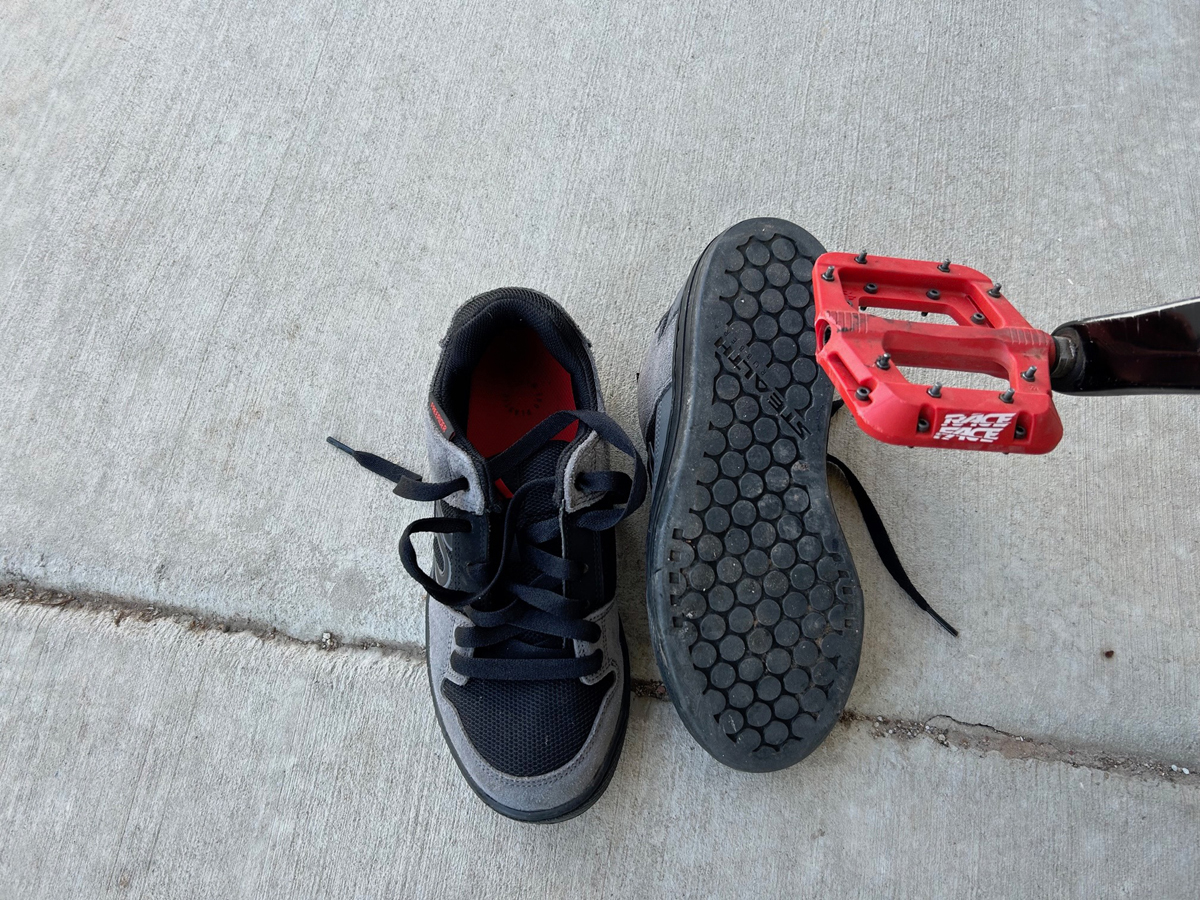
In the end we stayed with being clipped in for our trip for the short steep hills found in Custer State Park. If one just rode the trail and perhaps some of the gravel roads, the flat pedals would work great. I like the simplicity of the pedals and that I can use whatever shoe I happen to be wearing with the pedals though the Five 10 shoes seem to work well in tandem with the pedals. For a more comprehensive review of “clip-in pedals vs flat” go to the excellent article by Tom Jow in the Early Summer 2023 edition of Cycling West.
Giro Bike Shorts/Adventure Cycling Activewear long sleeve t-shirt by Craft
The Giro bike shorts are meant to be worn over a padded liner when cycling. I used the shorts to have pockets when going to a store as I don’t always use cycling jerseys with back pockets when I tour. The shorts are very comfortable, fit well and provided a small amount of added warmth on cool mornings due to the length. There is a zippered pocket on the right leg as well. On the two occasions I had a phone in this pocket, it stayed stable without any swaying with pedal motion. Light, packable and comfortable, a nice reason to pack the shorts along on trips.
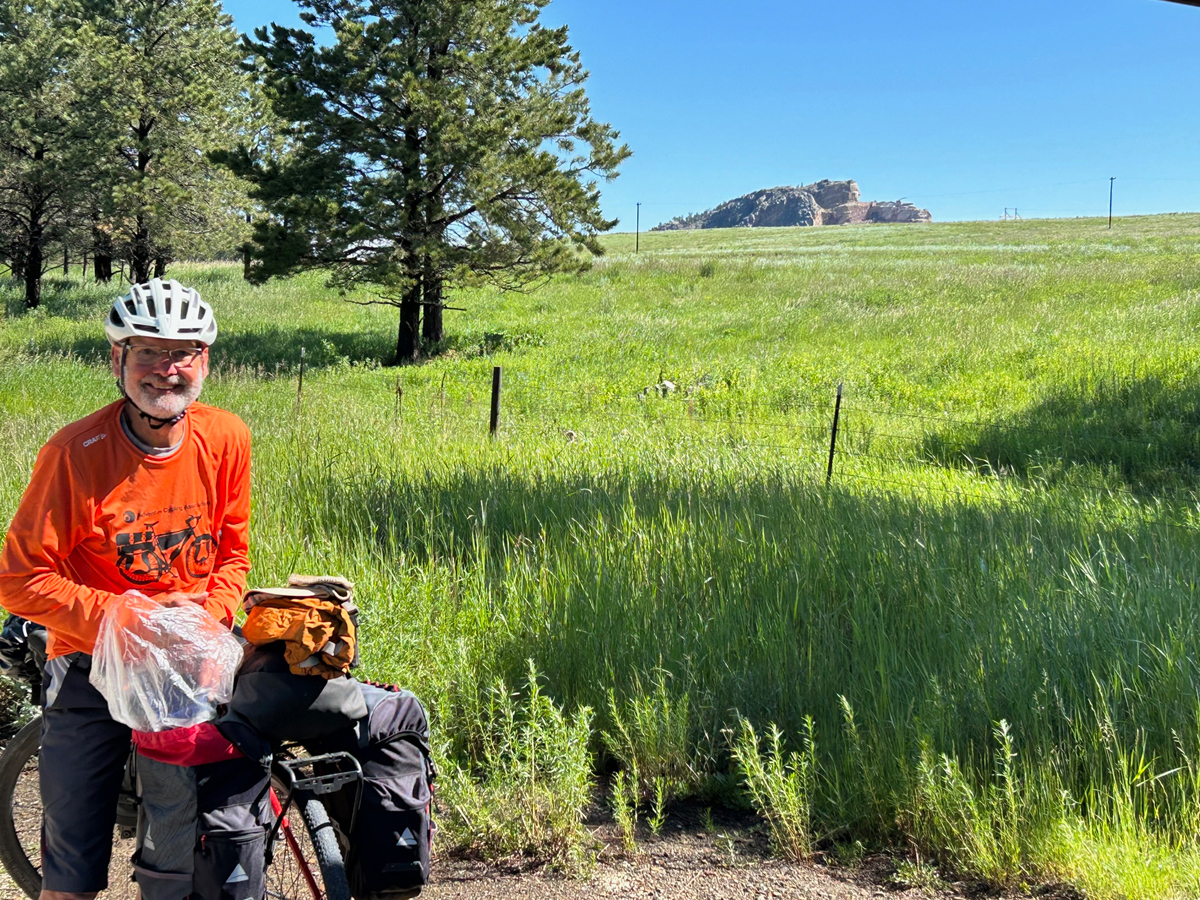
The Adventure Cycling Association jersey was meant to be a loose fitting, sun protection (SPF 35+) t-shirt on this trip. In the past I have found this shirt and others like it, to be cooler than sun protecting arm warmers. However, on this bike trip, the shirt was used to provide warmth in the cool mornings. As the temperatures rose. I find that the shirt is not overly warm. The “safety orange” color is nice when on the road.








